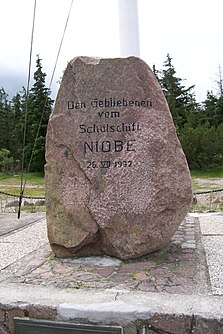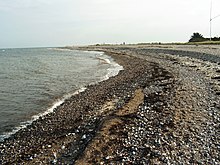Gammendorf
|
Gammendorf
City of Fehmarn
Coordinates: 54 ° 29 ′ 49 ″ N , 11 ° 8 ′ 46 ″ E
|
||
|---|---|---|
| Incorporation : | April 1, 1937 | |
| Incorporated into: | Country churches | |
| Postal code : | 23769 | |
| Area code : | 04371 | |
|
Location of Gammendorf in Fehmarn |
||
|
Memorial stone of the Niobe monument
|
||
Gammendorf is a village on the island of Fehmarn and a district of the city of Fehmarn in the Ostholstein district in Schleswig-Holstein .
history
The first more precise information about the Fehmarn villages can be found in the Waldemar-Erdbuch from 1231. This book contains everything that belongs to the Danish king. Gammendorf is also listed there with a size of 12 hooks . The hook is a Slavic land measure and comprises the area that can be plowed with a hook plow in one day, or the livelihood of a family. So it was a small village. The layout of the "Siedendorf", which has a U-shape open to the west, also indicates a Slavic origin. This form becomes even clearer if one looks at the settlement in earlier times. Then there is a much larger number of buildings in the east and north of the village. The second part of the village, the "Hohendorf", was probably founded by settlers from Saxony and other German tribes who had moved there. This immigration already begins when Heinrich von Bathide, during his campaign against the Slavs in Wagrien in the winter of 1138/39, completely exterminated this part of the population, at least on the mainland. From Fehmarn only the trip across the water should have prevented him.
In 1925 Gammendorf had 212 inhabitants.
building
| 1730 | 1784 | 1793 | 1803 | 1813 | 1833 | |
|---|---|---|---|---|---|---|
| Residential houses | 43 | 39 | 36 | 33 | 37 | 42 |
| Barns | 7th | 16 | 17th | 16 | 20th | 18th |
| Stables / cattle houses | 18th | 11 | 10 | 12 | 6th | 8th |
| Bakehouses | ? | 4th | 5 | 5 | 5 | 7th |
| Storage | ? | 0 | 0 | 0 | 0 | 0 |
| Other buildings | ? | 1 | 1 | 4th | 4th | 3 |
| total | ? | 71 | 69 | 70 | 72 | 78 |
Since 2013 there have been street names in Low German spelling in Gammendorf, some of which were named after the traditional names of the village parts such as "Hohendorf" and "Siedendorf", referring to the location, "Op de Reeg" or also used in High German "Auf der Row ", which means the houses in the middle of the village," Wurth ", named after an old field and facing east, then" In de Eck ", the corner on Strandweg. In detail these are: Hohendkör, Siedendbody, Osterliedt, Op de Reeg, An Flederbusch, Ton Strand, Wenkendkörper Weg. The outside courtyards Seelust, Kohbarg and Poggensiek are also named.
Origin of name
There are several ways to clarify the name Gammendorf . It can be related to the Danish language: Gammendorf > Gammeldorf , d. H. "Altdorf". However, there is a lack of evidence that justifies the name Altdorf.
location
The place is in the north of the island. Neighboring villages are Wenkendorf, Dänschendorf , Vadersdorf and Todendorf.
Quotes
Fehmarn's local researcher Peter Wiepert writes about Gammendorf: “Gammendorf, large farming village on the north coast, 11 km from Burg, Postbus. With 2 village parts, 'Hogen' and 'Siedendbody'. Large scale farms. To the north of the village there is a larger lake area with many small islets, called 'Oevers' (islets). A bird paradise, an interesting landscape with Reth, rushes, etc. all kinds of aquatic plants, revealing for botanists. "
The thing place
According to Peter Wiepert, the Gammendorfer Thingplatz is said to have been on Tancken, the village alley named after a previous resident. Around 1820 there were still twelve thingstones here, which over time fell victim to the building of houses and barns.
In the center of the stone circle, which was at least 32 feet in diameter (9-10 m), stood a stately hawthorn tree. The Gammendorfer were very proud of the tree, as the lower court attorney Witt reported in 1827.
Attractions
The Niobe monument stands on Gammendorfer Strand to commemorate the sinking of the Niobe sailing school ship on July 26, 1932, in which 69 people were killed.
Web links
Individual evidence
- ^ Michael Rademacher: German administrative history from the unification of the empire in 1871 to the reunification in 1990. holstein.html. (Online material for the dissertation, Osnabrück 2006).
- ^ Horst Manfred Rohde: Investigation of house and village on the island of Fehmarn . 1959



